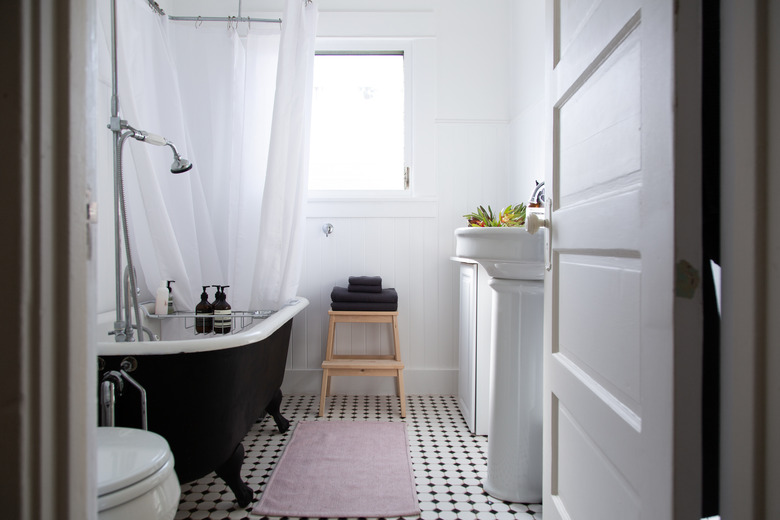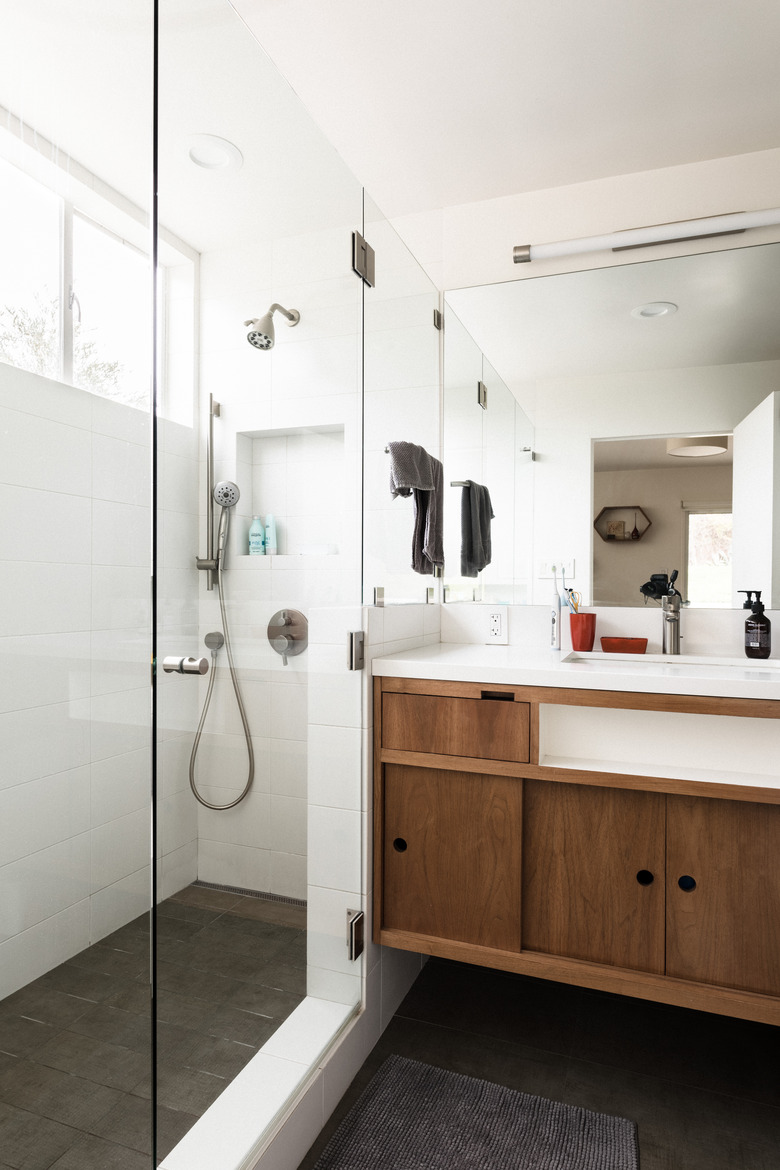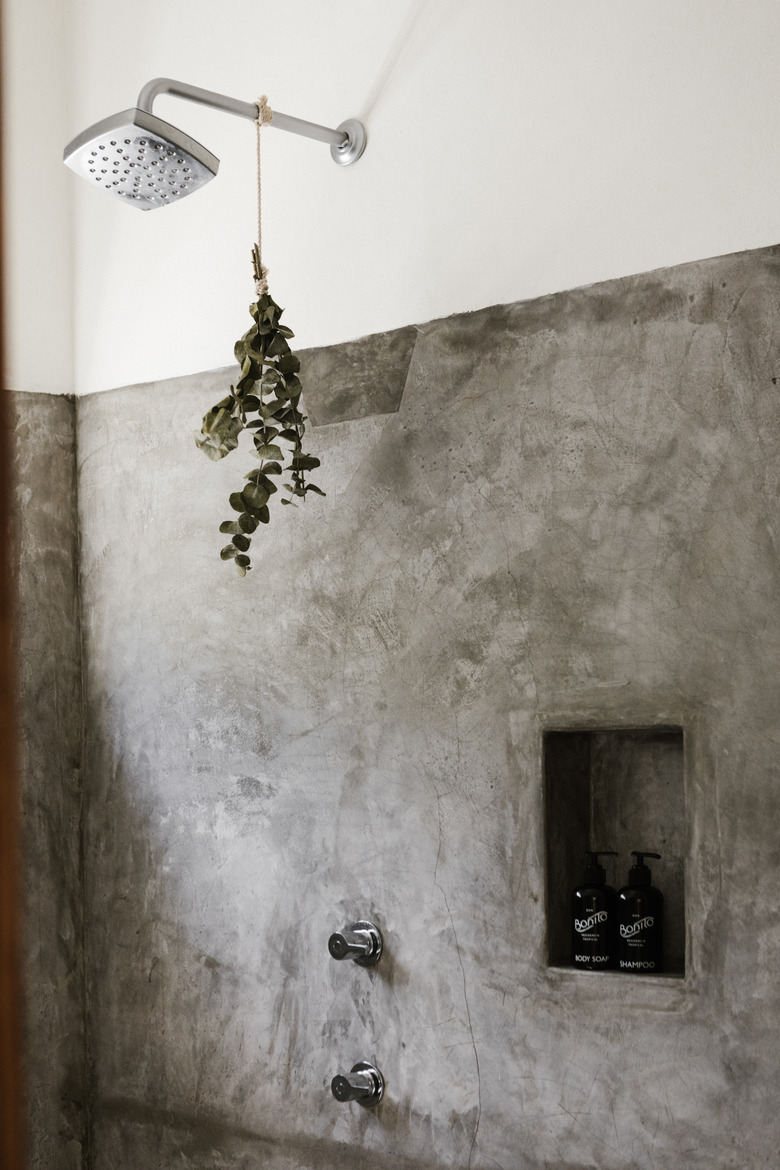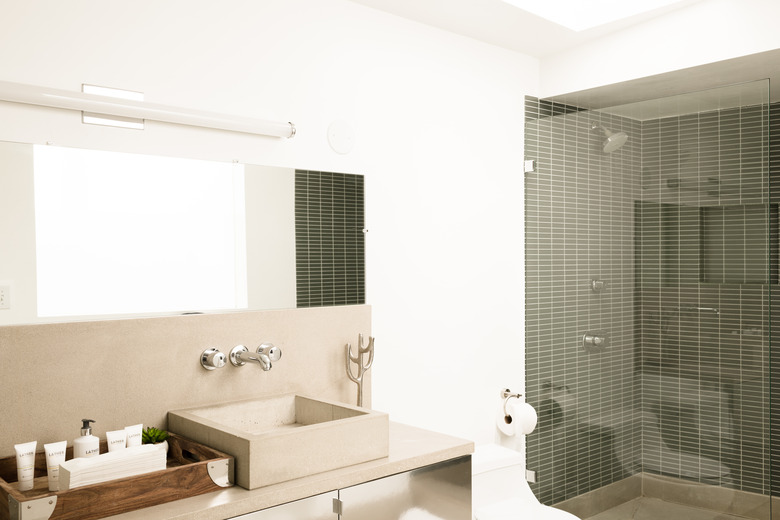Shower Shut-Off Valves: A Necessity For Home Repairs
We may receive a commission on purchases made from links.
While individual shut-off valves are required for nearly all plumbing fixtures in your home according to national codes, for some reason, they are not technically required for bathtubs and showers — at least not according to the most current national residential plumbing code. As enumerated the International Residential Code, Section P2903.9.3 of the plumbing code states that all plumbing fixtures other than bathtubs and showers must have individual shut-off valves fitted on their water supply pipes.
Formal national code requirements notwithstanding, most professional plumbers do install fixture shut-off valves for the shower and bathtub, and many local building jurisdictions do require them. Shower shut-off valves are a good idea for the same reason you use them elsewhere in your plumbing system: They provide a convenient place to shut off the water supply lines when your shower needs to be repaired or when parts need to be replaced or serviced.
The Function of Shower Shut-Off Valves
The Function of Shower Shut-Off Valves
The lack of a code requirement for shower shut-off valves is probably due to the fact that shower/bathtub plumbing is often enclosed by walls and floors, so the pipes and fittings are not immediately accessible (the code requires that all fixture shut-off valves be accessible). In the event of a burst pipe or loose water supply connection, you will quickly appreciate having shut-off valves for the shower pipes at easy reach. For this reason, during major remodeling projects, it's common for the contractor to install shut-off valves for the hot and cold water supply pipes. The locations for these valves can vary:
- Where construction layout allows it, the valves can be located behind an access panel built into the wall in or behind the bathroom. For example, where the plumbing wall abuts a closet or other living space, a removable wall panel can be constructed so that it can be easily removed to provide access to the shower shut-off valves. Many bathroom remodeling projects include building such an access panel if it doesn't already exist.
- Where a bathroom is built over an unfinished basement or crawl space, the shut-off valves can be located on the horizontal hot and cold pipes that run between exposed joists below the bathroom or at the point where the water supply risers turn upward toward the shower's plumbing tree. The shut-off valves can also be located behind a removable ceiling panel in the basement in cases where the basement ceiling is finished.
- In a plumbing system made with PEX flexible plumbing tubing, the shut-off valves for the shower and other plumbing fixtures are sometimes located at the central manifold that controls all the PEX tubing. This is usually located near the main shut-off valve for the house. In this instance, the shut-off valves sometimes control the water for the entire bathroom, including the sink and toilet.
Several different types of shut-off valves can be used to control the hot and cold water lines for a shower.
Standard Stop Valves and Ball or Gate Valves
Standard Stop Valves and Ball or Gate Valves
The standard fixture shut-off valves used for most plumbing fixtures are plastic or chrome-plated brass stop valves. These are in-line valves fitted into the hot and cold water pipes and usually connected to a smaller-diameter flexible supply tube leading to the faucets themselves. You are probably very familiar with this type of valve, as it is found beneath most sinks and toilets in your house.
However, this type of stop valve is somewhat unusual for a shower simply because showers are not usually plumbed with flexible supply tubes. Instead, showers are usually plumbed with regular plumbing pipes running to the hot and cold water inlets on the faucet mixing valve, and this calls for a different type of shut-off valve.
Ball or gate valves are the same types of valves normally used to control plumbing branch lines. When used as shower shut-off valves, they are installed in line within water supply pipes running to the shower so that a 1/2-inch plumbing pipe entering one side of the valve leaves the other side of the valve via another 1/2-inch pipe that then runs to the shower mixing valve inlets.
These valves operate with a lever or knurled knob that is rotated to open and close the water flow. This is a very common type of valve for shower shut-off valves. Depending on the type of pipe, they can be made of either plastic or brass.
Faucet Integrated Valves
Faucet Integrated Valves
Many shower faucets have integrated valves designed into the body of the mixing valve itself, used to control the hot water and cold water flow. These valves are opened and closed by turning a recessed slotted screw head with a large standard screwdriver. You normally access these integrated valves by removing the escutcheon plate covering the front of the faucet.
Some plumbers and DIYers omit installing separate shut-off valves if the shower faucet is equipped with integrated valves, but integrated valves are most effective when all you need to do is service the faucet itself, such as when replacing a cartridge that is leaking. They are quite useless if the problem is more serious, such as when a water supply pipe ruptures or a pipe joint fails. For this reason, it is best to install shower shut-off valves on the pipes themselves even if your shower faucet has integrated shut-off valves.
Shut-Off Valves for Copper and Plastic Pipes
Shut-Off Valves for Copper and Plastic Pipes
Installing shower shut-off valves is easiest if you do it while the plumbing lines are being installed for the shower. In this instance, the valves are installed in sequential order as the water supply pipes are linked piece by piece to the faucet mixing valve. Shut-off valves can also be installed as a retrofit operation by splicing the valves into existing pipes. The method of connecting the valves depends on the type of plumbing pipe used in your system: copper, rigid plastic or PEX.
Copper is a classic form of pipe that is found in many homes built or updated after the 1940s. Shut-off valves can be installed with copper pipes in several ways:
- Sweat-soldered fittings, in which the joints between pipes and the valve are welded shut with metal solder liquefied under heat
- Compression fittings, in which the valves slide over the pipes and are secured with brass compression rings that are squeezed down against the pipes when compression nuts are tightened
- Grip-fit valves, a newer type of valve that has an internal seal that creates a tight watertight seal against the pipe. With grip-fit valves, a retainer ring with sharp teeth secures the valve in place around the pipe (one popular brand name for these fittings is SharkBite).
CPVC is an early generation of plastic plumbing pipe that is usually assembled with solvent glue that melts and bonds the plastic fittings to the plastic pipes. There are plastic shut-off valves designed specially for use with rigid plastic pipes. Rigid plastic can also be fitted with metal shut-off valves that use compression fittings or push fittings. Installing shower shut-off valves in a retrofit project is fairly easy with rigid plastic pipe since it is very easy to cut.
Occasionally, you may find water pipes made of another rigid plastic, PVC — the same white or cream-colored plastic that is used for many drain pipes. PVC is not regarded as a suitable material for hot water pipes, so it is rarely used anymore. Where you find it, PVC can be fitted with shut-off valves using the same types of valves that are used for CPVC.
Shut-Off Valves for PEX
Shut-Off Valves for PEX
PEX is a recent generation of plastic tubing that is steadily becoming the favorite choice of both professional and DIY plumbers. Originated in the 1980s for use in radiant floor heating systems, improvements in the product gradually made PEX a viable material for water supply lines, and today, 60 percent of all plumbing installations use PEX rather than other types of plumbing pipe.
PEX (cross-linked polyethylene) is a flexible tubing that can be bent around corners and snaked through wall and floor cavities, making it very easy to install. PEX is available in red, blue and white tubing. Red is generally used for hot water lines, blue is used for cold water lines and white tubing can be used for either hot or cold water lines.
PEX tubing is generally joined together with brass fittings and crimp rings that squeeze the tubing against the fittings for a watertight seal. This requires a special tool designed for the crimping operation, but DIYers quickly find that PEX is much easier to use than copper pipe joined with sweat-soldered fittings requiring a propane torch. In remodeling operations, it is quite easy to extend or replace copper or rigid plastic pipe with PEX tubing by using special transition fittings.
There are shut-off valves designed specifically for use with PEX, which are secured to the tubing with the same crimp rings used for other types of PEX fittings. However, you can also use metal or plastic valves with push fittings on PEX tubing. This requires the use of a rigid insert that is pushed into the tubing before it is inserted in the valve's push-fit socket.
Installing Shower Shut-Off Valves
Installing Shower Shut-Off Valves
Push-fit valves can be used with any type of plumbing pipe. Most push-fit valves come with all parts needed to connect to any type of pipe, including PEX.
Warning
Shut off the water supply to the shower before you begin the project. This will usually mean shutting off the water at the main water supply valve for the home.
- Find an accessible location for installing the shower shut-off valves. Common locations include behind the access panel for the shower plumbing tree or in a basement or crawl space where the plumbing for the bathroom is exposed.
- Measure and cut away the hot and cold water pipes where the valves will be installed. The tool you use to do this will depend on the type of plumbing pipe present. A tubing cutter designed for the type of material is the best choice. Make sure the segment of pipe you remove is exactly the right measurement for the valve you will install. Take care not to cut away too much pipe, as it will then be hard to splice in the valve.
- If you are using PEX tubing, insert the valve's rigid inserts into each exposed end of the tubing. These inserts will make the tubing rigid enough to accept the push-fit valve without bending.
- Slide one end of the severed plumbing pipe for the hot water line firmly into one outlet on the valve, making sure it is firmly seated all the way to the shoulder of the valve socket.
- Push the remaining end of pipe into the other outlet on the push-fit valve, again seating it firmly against the shoulder of the valve socket.
- Repeat the previous steps for the cold water line running to the shower faucet.
- Turn on the water and check for leaks at the joints around each shut-off valve. With the shower faucet open and water running, turn each shut-off valve on and off several times to verify that it operates correctly.



